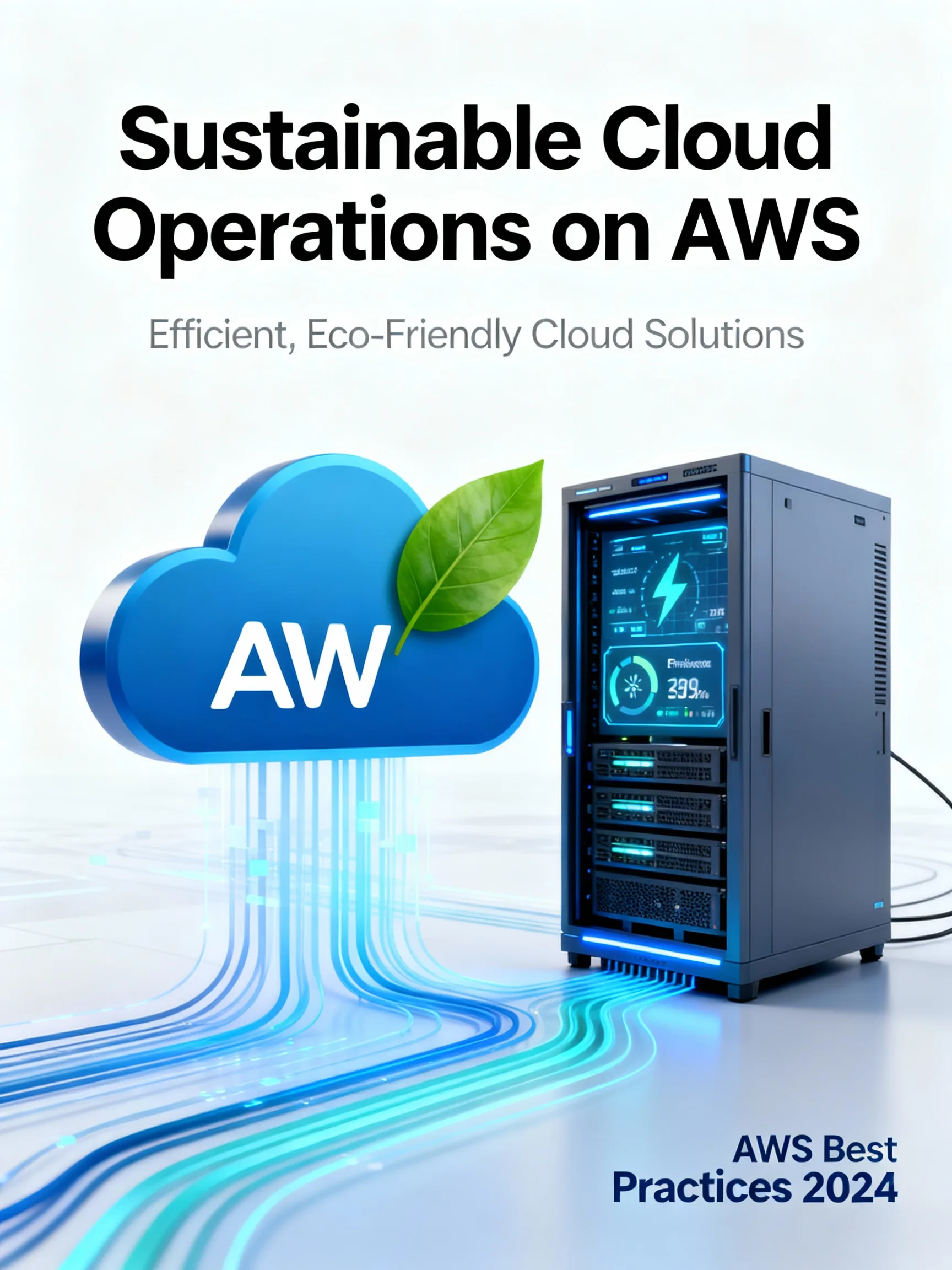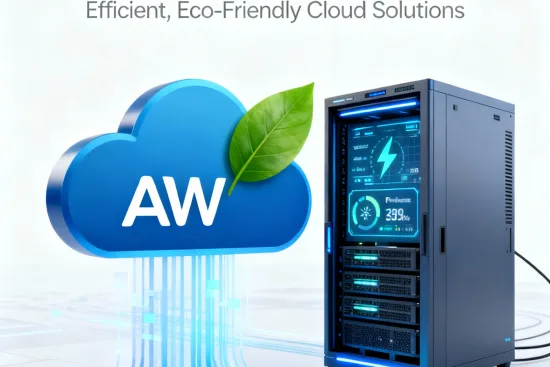
Sustainable cloud operations on AWS combine cost efficiency with environmental responsibility, helping organizations reduce both cloud spend and carbon footprint. By designing workloads with efficiency, observability, and automation in mind, teams can deliver better performance using fewer resources. This article explains practical ways to build and run sustainable architectures on AWS without sacrificing reliability or speed.
Understanding Sustainability in the AWS Cloud
Cloud sustainability is about doing more with less computing power. Instead of only focusing on uptime and feature delivery, teams also optimize for energy efficiency and carbon impact. AWS operates on a shared responsibility model for sustainability: AWS improves the efficiency of its infrastructure, while customers are responsible for designing efficient workloads and choosing greener options.
AWS data centers are typically more energy efficient than traditional on-premises environments, but simply “lifting and shifting” inefficient workloads into the cloud does not guarantee sustainability. You still need to right-size resources, reduce waste, and monitor usage patterns. AWS provides tools, such as the Customer Carbon Footprint Tool and AWS Well-Architected Sustainability Pillar, to guide these efforts.
Embedding sustainability into your cloud strategy can also align with broader ESG goals, regulatory requirements, and customer expectations. When treated as a core architectural principle, sustainable cloud operations on AWS lead to simpler architectures, lower bills, and easier-to-maintain systems.
Architecting Efficient and Sustainable Workloads
Designing for sustainability starts with architecture. The way you structure applications, choose services, and handle demand has a direct impact on energy use and emissions. The goal is to match capacity as closely as possible to real demand, while avoiding overprovisioning and idle resources.
First, embrace managed and serverless services where appropriate. Services like AWS Lambda, Fargate, DynamoDB, and Amazon S3 often run at higher utilization in AWS-managed fleets than typical self-managed EC2 clusters. Because AWS can consolidate workloads across many customers, it uses fewer underlying servers for the same amount of work, improving energy efficiency. For example, replacing a lightly used EC2-based API with Lambda and API Gateway can reduce always-on compute time and associated emissions.
Second, apply right-sizing and autoscaling consistently. Many organizations find 30 to 50 percent overprovisioning in their EC2 fleets when they first analyze utilization. Regularly review metrics such as CPU, memory, and network usage, and adjust instance types to match observed patterns. Use Amazon EC2 Auto Scaling or Application Auto Scaling to scale out during peak periods and scale in when demand drops, so you are not paying for idle capacity.
Third, choose storage and data patterns with care. Store data in the most appropriate tier: S3 Intelligent-Tiering or Glacier can drastically reduce the footprint of cold data compared to keeping everything on high-performance volumes. In databases, use read replicas, caching layers, and efficient indexing so that fewer resources are required to satisfy each request. Even small changes in query efficiency can have large cumulative effects on energy use.
Measuring, Optimizing, and Automating for Sustainability
You cannot improve what you do not measure. Sustainable cloud operations on AWS depend on clear visibility into resource usage, cost, and emissions. Start by enabling the AWS Customer Carbon Footprint Tool in the Billing console to gain a high-level view of the carbon emissions associated with your AWS usage. While this data is aggregated, it helps track trends over time and see the impact of optimization efforts.
Next, integrate sustainability metrics into existing observability and governance processes. Use AWS Cost Explorer and AWS Compute Optimizer to identify underutilized resources, then correlate those findings with application performance dashboards in Amazon CloudWatch. A simple practice is to establish a utilization target—for example, aiming for CPU utilization between 40 and 60 percent for non-latency-sensitive workloads—and track drift through dashboards and alerts.
Automation is critical to making these improvements stick. Use Infrastructure as Code (IaC) tools like AWS CloudFormation or Terraform to codify right-sized configurations, autoscaling policies, and lifecycle rules. This ensures efficiency decisions are repeatable and consistently applied across environments. You can also use AWS Systems Manager and Lambda to automatically shut down non-production environments outside of working hours, which often saves 50 to 70 percent of dev and test compute usage.
Another useful pattern is implementing data lifecycle policies. Configure S3 lifecycle rules to transition logs and backups to colder storage after a defined period, and to delete them when they are no longer needed. This reduces storage consumption and aligns with principles of data minimization, while also reducing the energy required to maintain unnecessary data.
Leveraging AWS Regions, Hardware, and Procurement Choices
Where and how you run workloads on AWS also influences their sustainability profile. AWS operates multiple regions, many of which are powered with a high percentage of renewable energy. Reviewing region-level information and aligning workloads with regions that have lower carbon intensity—while respecting data residency and latency requirements—can materially reduce emissions.
For some workloads, moving compute closer to users or data sources can further improve efficiency. Using content delivery through Amazon CloudFront or processing data at the edge can lower network transfer and reduce the number of round trips to central regions, cutting both latency and energy use. Similarly, consolidating lightly used workloads into fewer regions or accounts may simplify management and reduce the overhead of duplicated infrastructure.
Hardware choices also matter. AWS Graviton-based instances, powered by ARM processors, are designed to deliver better performance per watt compared with many x86 instances. Organizations often see cost reductions of 20 to 40 percent and higher energy efficiency after migrating suitable workloads to Graviton. Begin with stateless services or containerized workloads, test compatibility, and then progressively roll out Graviton instances where performance and compatibility are acceptable.
Procurement and pricing models support sustainability as well. By using Savings Plans, Spot Instances, and reserved capacity wisely, you encourage stable, predictable usage patterns that are easier to manage efficiently. Combining these purchasing options with rightsizing and autoscaling helps avoid over-allocation of resources, minimizing both cost and carbon impact.
Building a Culture of Sustainable Cloud Operations
Technology alone does not guarantee sustainable cloud operations on AWS; you also need the right culture and processes. Start by making sustainability an explicit non-functional requirement in architectural decisions. When evaluating design options, consider not only cost, security, and reliability, but also the energy implications of each approach.
Introduce sustainability goals and KPIs into engineering roadmaps. Example goals include reducing idle resources by a given percentage, increasing the share of serverless or managed services for new workloads, or migrating a specific portion of compute to more efficient instance families. Track these goals in the same way you track performance or availability targets.
Documentation and knowledge sharing are essential. Capture best practices in internal playbooks, such as “default to Graviton where feasible” or “require utilization reviews before scaling up.” Encourage teams to conduct sustainability reviews using the AWS Well-Architected Tool, focusing on the Sustainability Pillar alongside the existing pillars.
Finally, communicate results. Reporting on reduced cloud costs, smaller infrastructure footprints, and improved efficiency reinforces the value of the effort and motivates ongoing improvements. Over time, sustainability becomes a natural part of how your organization designs, builds, and operates in the cloud.
By combining thoughtful architecture, rigorous measurement, regional and hardware choices, and a sustainability-focused culture, organizations can achieve truly sustainable cloud operations on AWS. These practices lower environmental impact, reduce costs, and simplify systems, allowing teams to deliver resilient, high-performing applications that are better for both the business and the planet.






Leave a Reply